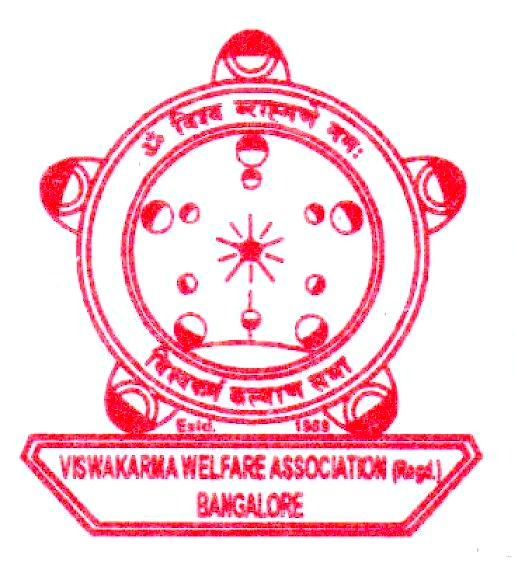
About Vishwakarma
The Vishwakarma (sometimes Visvakarma) community refer to themselves as the Viswabrahmin, and are sometimes described as an Indian caste. The community comprises five sub-groups —carpenters, blacksmiths, bell metalworkers, goldsmiths and stonemasons—who believe that they are descendants of Vishwakarma, a Hindu deity.
They worship various forms of this deity and follow five Vedas—Rigveda, Yajurveda, Samaveda, Atharvaveda, and Pranava Veda.
Vishwakarmas are a community or caste who have adopted engineering, art and architecture professions in India, and are followers of Lord Vishwakarma. They are found all over India. They comprise blacksmith, carpenter, metalcraftsmanstone-carver, goldsmith. Being largely descended from Brahmins, Hindu law permits them to wear the sacred thread, perform various priestly duties and accords them a position equal to that of Brahmins. Hence, they are also known as Vishwa Brahmin (विश्वब्राह्मण) .
The communal name of Vishwakarma is of fairly recent usage.[2] The British Raj misunderstood the Indian caste system as being an inflexible concept based onvarna, ignoring all evidence of caste creation and disintegration caused by processes of social fission and fusion. This flawed interpretation, formed in part by heeding the work of Brahmin scholars, resulted in many communities aspiring to official recognition of a higher social status than was traditional, based on claims of descent from elite groups such as the Brahmins or Kshatriyas. Among the changes that occurred during this period, the census administrator John Henry Hutton recorded in 1931 a caste called the Vishwakarma, which was an administrative creation defined as a community of artisans who were geographically disparate but shared fairly similar occupations. Like the similarly-created Yadavs, who were an administrative grouping of grazers, herders and dairymen, the Vishwakarma comprised numerous previously diverse castes.[3] The community prefer the new name, which has evidential support in 12th-century inscriptions that refer to smiths and sculptors belonging to the Vishwakarma kula, although Vijaya Ramaswamy notes that "... the Vishwakarma community is obviously cutting across caste lines" and "... comprises five socially and economically differentiated jatis". Prior to the Raj period, these communities were referred to names such as Kammalar in present-day Tamil Nadu and Kerala, Panchalar in Karnataka and Panchanamuvaru in Andhra Pradesh, while there are also medieval inscriptions that refer to them as the Rathakarar and Kammala-Rathakarar.
Origin
The god Vishwakarma is considered by followers of the Hindu faith to be the divine architect or engineer of the universe. He had five children - Manu, Maya,Tvastar, Shilpi and Visvajna — and these are believed by the Vishwakarma community to have been the forebears of their five sub-groups, being respectively thegotras (clans) of blacksmiths, carpenters, bell metalworkers (metal casters), stonemasons and goldsmiths.[2] It is not known whether these five subgroups historically practiced endogamy, which is a frequently-found feature of the Indian caste system.
Position in society
They have claimed a higher social status for many years and believe that the trades which they traditionally follow are superior to the work of a manual labourer because they require artistic and scientific skills as well as those of the hand. According to George Varghese, their claim to high status is "one of the mainstays of Viskwakarma identity" in what is otherwise a fragmented, incoherent community that has often suffered from internal differences of opinion.[2] Their claim has been voiced by Edava Somanathan, a member of the community and its only historian in the written word. Somanathan's works, according to Varghese, "... are written from a pro-community perspective. Therefore, there are a lot of exaggerations and anti-brahmin tirades in them". Somanathan argues that the artisanal groups were a part of the Indus Valley Civilisation, pre-dating the arrival of Brahmins and their caste-based division of society. He claims remarkable achievements are evidenced in both the arts and sciences during that egalitarian pre-Brahmin era, including the construction of aeroplanes.[2] This claim to Brahmin status is not generally accepted outside the community, despite their assumption of some high-caste traits, such as wearing the sacred thread, and the Brahminisation of their rituals. For example, the sociologist M. N. Srinivas, who developed the concept of sanskritisation, juxtaposed the success of the Lingayat caste in achieving advancement within Karnataka society by such means with the failure of the Vishwakarma to achieve the same. Their position as a left-hand caste has not aided their ambition.[5] They have been included in the list of Other Backward Classes in some states of North India.[6]
